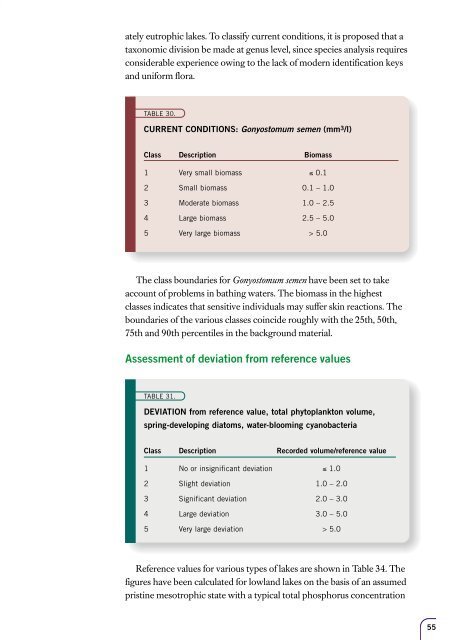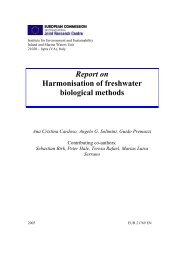Lakes and Watercourses
Lakes and Watercourses
Lakes and Watercourses
Create successful ePaper yourself
Turn your PDF publications into a flip-book with our unique Google optimized e-Paper software.
ately eutrophic lakes. To classify current conditions, it is proposed that a<br />
taxonomic division be made at genus level, since species analysis requires<br />
considerable experience owing to the lack of modern identification keys<br />
<strong>and</strong> uniform flora.<br />
TABLE 30.<br />
CURRENT CONDITIONS: Gonyostomum semen (mm 3 /l)<br />
Class Description Biomass<br />
1 Very small biomass ≤ 0.1<br />
2 Small biomass 0.1 – 1.0<br />
3 Moderate biomass 1.0 – 2.5<br />
4 Large biomass 2.5 – 5.0<br />
5 Very large biomass > 5.0<br />
The class boundaries for Gonyostomum semen have been set to take<br />
account of problems in bathing waters. The biomass in the highest<br />
classes indicates that sensitive individuals may suffer skin reactions. The<br />
boundaries of the various classes coincide roughly with the 25th, 50th,<br />
75th <strong>and</strong> 90th percentiles in the background material.<br />
Assessment of deviation from reference values<br />
TABLE 31.<br />
DEVIATION from reference value, total phytoplankton volume,<br />
spring-developing diatoms, water-blooming cyanobacteria<br />
Class Description Recorded volume/reference value<br />
1 No or insignificant deviation ≤ 1.0<br />
2 Slight deviation 1.0 – 2.0<br />
3 Significant deviation 2.0 – 3.0<br />
4 Large deviation 3.0 – 5.0<br />
5 Very large deviation > 5.0<br />
Reference values for various types of lakes are shown in Table 34. The<br />
figures have been calculated for lowl<strong>and</strong> lakes on the basis of an assumed<br />
pristine mesotrophic state with a typical total phosphorus concentration<br />
55















![Accommodation booking form [PDF]](https://img.yumpu.com/39471785/1/184x260/accommodation-booking-form-pdf.jpg?quality=85)

